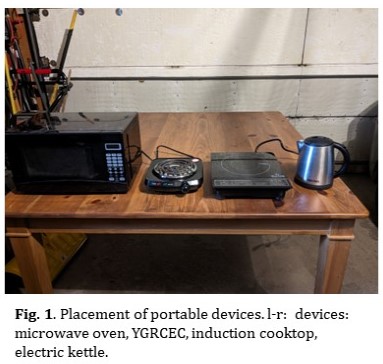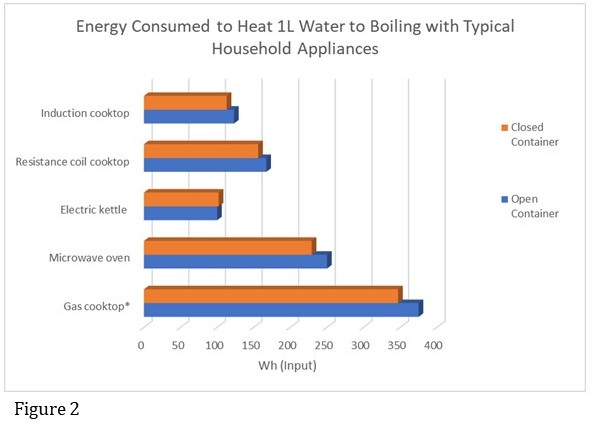Comparing energy efficiency of boiling water: household appliances Michael D. Eissenberg, BSME, PE, Leed AP*, and Joel C. Eissenberg, Ph.D.* *co-corresponding authors Abstract Kitchen appliances use various mechanisms to heat, with differences in energy sources and geometry. The goal of this study was to compare energy efficiency across common household appliances. To facilitate comparison, 1 L of water was used as the heating substrate and onset of boiling was chosen as the endpoint. In this comparison, heating in an electric kettle proved to be the most energy efficient, and heating in a pot on a gas cooktop was the least energy efficient. In most cases, a closed cover added to the efficiency. IntroductionWith the proliferation of
Topics:
Joel Eissenberg considers the following as important: boiling water, comparison, Education, energy efficiency of household appliance, Featured Stories, Hot Topics, US EConomics, US/Global Economics
This could be interesting, too:
NewDealdemocrat writes JOLTS revisions from Yesterday’s Report
Joel Eissenberg writes No Invading Allies Act
Ken Melvin writes A Developed Taste
Bill Haskell writes The North American Automobile Industry Waits for Trump and the Gov. to Act
Comparing energy efficiency of boiling water: household appliances
Michael D. Eissenberg, BSME, PE, Leed AP*, and Joel C. Eissenberg, Ph.D.*
*co-corresponding authors
Abstract
Kitchen appliances use various mechanisms to heat, with differences in energy sources and geometry. The goal of this study was to compare energy efficiency across common household appliances. To facilitate comparison, 1 L of water was used as the heating substrate and onset of boiling was chosen as the endpoint. In this comparison, heating in an electric kettle proved to be the most energy efficient, and heating in a pot on a gas cooktop was the least energy efficient. In most cases, a closed cover added to the efficiency.
Introduction
With the proliferation of kitchen appliances, the question naturally arises as to which cooking mechanism is most efficient. Concern for global warming demands the choice of the most efficient cooking mechanism.
To our knowledge, there are no published comparisons to resolve the question. To address this gap in the literature, we have compared the energy consumed to boil a liter of water under atmospheric pressure using (1) your grandmother’s resistance coil electric cooktop (hereafter YGRCEC), (2) standard kitchen gas cooktop (hereafter SKGC), electric kettle, microwave oven and induction cooktop. The energy consumed in uncovered versus covered vessels was also addressed in our study.
Materials and Methods
All measurements were conducted at Evergreen Energy Efficiency Laboratories, Evergreen CO at 7440 feet ASL and 64°F. Local tap water (56.5°F) sourced from Evergreen Metropolitan Water District. For induction cooktop, YGRCEC, SKGC and gas cooktop measurements, a Cuisinart® Model #MCP19-18N 1.9 L stainless steel saucepan was used, with or without an unfitted glass lid. For microwave oven measurements, water was heated in a Pyrex® 1 quart measuring cup with or without an unfitted ceramic plate lid. The endpoint for each measurement is defined as the onset of a rolling boil for 1 L tap water (subjective visual assessment by a single observer). BP=194.2°F
Heating devices
Induction cooktop: Duxtop single surface
Gas cooktop: Ikea
Microwave oven: Walmart
Electric kettle: Aroma®
Resistance coil electric cooktop: Walmart
Boiling water detector: Linda G. Eissenberg, Ph.D.
Energy consumption measurement:
electrical: La Crosse Tech Cost Control watt hour meter (model #3362U)
gas: Xcel Energy natural gas meter
Conversion of cubic feet gas to watt hrs:
Results
All portable test devices were placed on the same table, side-by-side (Fig. 1). The SKGC was located approximately three meters away, but at the same elevation from the floor as the other devices. Since a microwave thermometer was unavailable, we elected to define the endpoint of each measurement as onset of a rolling boil. Rolling boil was defined by the same observer to insure consistency.

A single data point was obtained under each condition (Fig. 2). For the gas cooktop, the cubic feet of gas consumed was measured using the utility gas meter after other gas-powered devices were deactivated and a conversion formula was used to estimate Wh of energy consumed (see Materials and Methods).

Discussion
Many households provide multiple options for boiling water. A typical furnished apartment or home would likely have some kind of heated cooking surface (resistance coil, gas, induction cooktop). Electric kettles have significantly penetrated the residential water heating market, but aren’t as common. Microwave ovens, either built-in or portable, are quite common in residential kitchens.
The clear winner in our study was the electric kettle. It is important to note, however, that this is a single application device optimized for the task of boiling water, whereas all the other comparators are capable of heating/cooking/boiling a wide variety of substrates. The gas cooktop proved to be by far the least efficient way to boil a liter of water.
Of the devices tested, induction cooktops represent the most recently commercialized technology. While the induction cooktops rank highest in energy efficiency compared to all cooktops and the microwave oven, they require the use of induction compatible cookware. By this consideration, microwave ovens gain an advantage, since unlike cooktops, a wide variety of glass, ceramic and even plastic containers can be used, as well as containers with irregular bottom surfaces.
In the case of the microwave oven, the input power was 1050 watts, while the output power was 700 watts. Thus, 29% of the input power is explicitly lost to the inefficiencies of the design of the microwave oven and unavailable for water heating. Since this study is meant to account for any inefficiencies in appliance operation, it is appropriate to use the total input energy in the comparisons to other devices.
Unsurprisingly, we found that boiling water in a closed container is somewhat more energy-efficient than boiling water in an open container. The exception was the electric kettle, where the open kettle was ca. 2% more efficient. The rank order of efficiency between the devices didn’t change with or without a closure.
Many studies that include comparing devices that operate using natural gas and similar devices using electricity identify the fact that the production of electricity often includes the combustion of natural gas or other fossil fuels. The inefficiencies associated with the conversion from fossil fuel to electricity aren’t accounted for in this study. Before considering the use of an electricity-sourced appliance in place of a natural gas-sourced appliance, a careful accounting of this must be considered.
Future studies should include experimental replicates and multiple manufacturers of each device category. Nevertheless, our study can serve as a guide to action in deciding the most energy-efficient kitchen device.
Acknowledgements
The authors thank Mr. Ryan Franz for helpful discussion.

